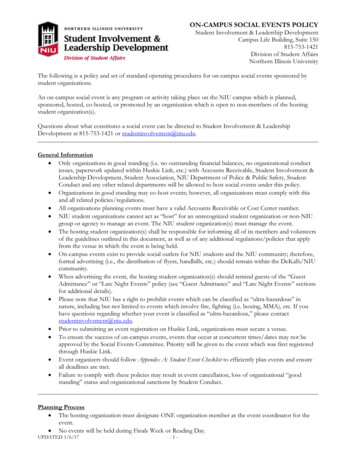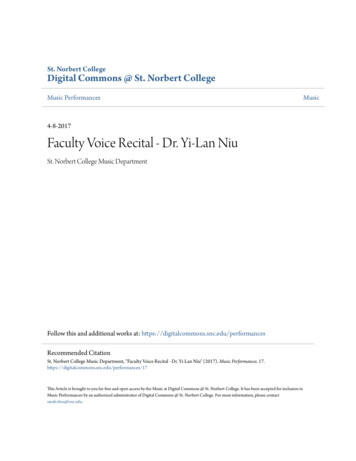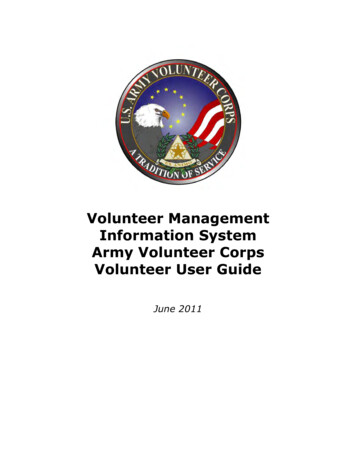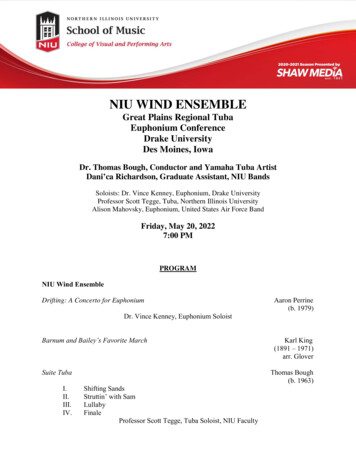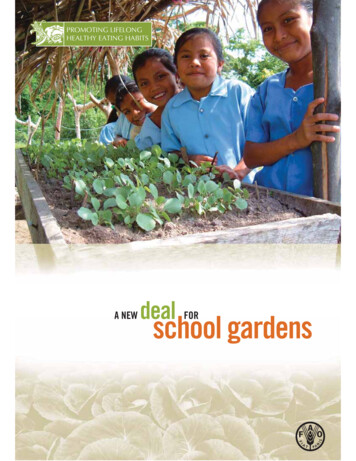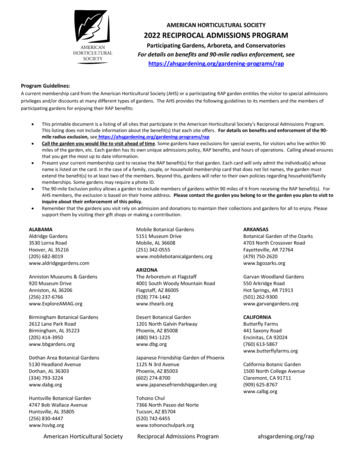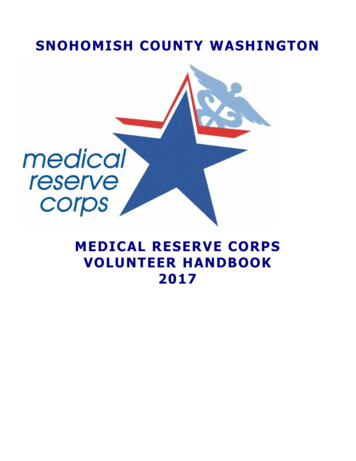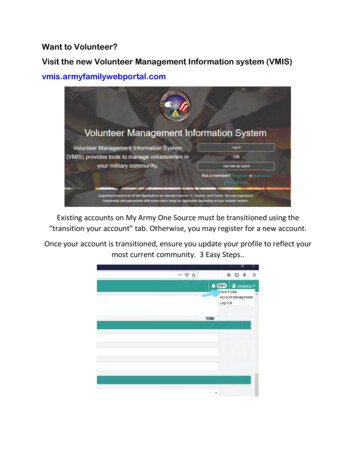
Transcription
NIU Communiversity Gardens2018 Volunteer GuideDeKalbgardens.org - niu.edu/communiversitygardensDeKalb County Community Gardens (DCCG) and NIU Communiversity Gardens (NIUCG)Goals and Objectives: Strengthen people’s access to local, sustainably grown produce Donate produce to food pantries, day care centers, schools, meals on wheels programs,and other similar locations Fortify relationships within the community of DeKalb County Promote awareness for and educate public about local food systems that benefit theenvironment and address the food shortages in DeKalb County Teach members of the community how to gardenMap of NIU Communiversity Garden (2015)Located outside Anderson Hall on Garden Rd, DeKalb, ILEach plot number is labeled with a brick on the outer edge so you caneasily locate the different plots. There are also maps in the shed if youwant to reference it while out in the garden.
1. History of DCCG and NIUCGDCCG began in 2012 and has over 50 locations around DeKalb County. Theorganization has donated more than ten tons of food to a variety of places in need ofnutritious produce.NIUCG started in 2014 and has several locations around campus. The primarylocation is the Sandra Streed Garden adjacent to Anderson Hall. Most of the producefrom NIUCG is donated to the Huskie Food Pantry located in the Chick Evans FieldHouse. The Huskie Food Pantry primarily supports students who are food insecure.2. Liability Waiver and StatementEach person who volunteers in the NIU Communiversity Gardens is expected to readthe “Assumptions of Risks and Liability Release Agreement” as well as theassociated “Visual and Audio Documentation” release. Copies of these documents arefound in the volunteer binder and online NNazNaWnhPM0E/view?usp sharing3. Getting StartedThe shed is the main base of operation. The shed houses the tools, gloves, water keys,garden stakes, volunteer binder, and other garden necessities. Watering supplies(hoses, nozzles, and watering cans) are located in the plastic storage box adjacent toAnderson Hall. All tools and supplies need to be returned to their proper location bythe end of each volunteer day.4. Volunteer PositionsA few seasoned, consistent volunteers are referred to as Lead Volunteers. They arewell-versed in the garden and understand how to do almost every task available.Along with the interns and co-managers, they will assign tasks for volunteers. If youare interested in the role of Lead Volunteer or Garden Intern, contact the co-managers(Melissa Burlingame and Michaela Holtz) about current and future opportunities atniucg@niu.edu.5. AttendanceMake sure you mark the time you begin and end your volunteer hours in the volunteerbinder inside the shed. A member of the garden management team (interns, leadvolunteers, or co-managers) will have this handy, so just ask one of them for the logto mark your attendance. This not only assists in documenting your valuablevolunteer time, but helps us write grants which allows us to have more funding tosupport the garden!If you would like your attendance documented for Business Passport (P) or HonorsEngaged (H), be sure to indicate the appropriate designator in the margin on the
volunteer sign in sheet. If you need a form signed for class, any member of themanagement team can sign the paperwork for you.6. AttireIt is best to wear clothing and shoes you don’t mind getting muddy or dirty since thegardens tend to get a bit messy with some projects. Sturdy boots are recommended tobest protect your feet and for easier shovel use. Pants and long-sleeve shirts aregenerally recommended as well to best protect you from the sun and biting insects,but you are welcome to wear whatever you feel comfortable in as long as it issocially-appropriate attire.7. Personal ItemsYour personal items are your responsibility while you volunteer. There are spaces totemporarily place your items like back packs. If you would like to keep a pair ofshoes, garden gloves, or personal tools on site, please email a member of themanagement team at niucg@niu.edu to discuss arrangements.8. EligibilityVolunteering is open to all persons age 18 and older (see liability statement andwaiver). Any person under the age of 18 should be accompanied by a responsibleguardian or chaperone.9. Shed OrganizationGenerally, the shed has all of the tools necessary to complete projects in the garden.Please keep the shed as organized as possible by returning tools to their original spotswhen you are done with them. Gloves should be folded together and tools should befree of debris (see tool maintenance).10. Tool MaintenanceMake sure to wash off or scrape the soil off tools before returning them to theirproper locations in the shed. This will help to prevent them from rusting and willallow them to work as well as possible! Please return tools to shed once you arefinished using them and not at the end of your work day to ensure the tools are allaccounted for. If a tool breaks, please let a lead volunteer, intern, or co-manager knowso they can account for it.**Safety Alert**Make sure to place shovels upside-down when laying them down outside so no onegets injured. We don’t want any Daffy Duck incidents!
11. Clean UpPlease make sure all the tools are cleaned and that there aren’t any materials or toolsleft around the garden. Also, empty the hoses of water before putting them away.Lastly, make sure to put the water key away in its proper location and double checkthat the water is securely turned off.12. PlantingPlanting varies upon which seeds are being planted and which plants are ready fortransplant. Please consult with the lead volunteers, as planting only takes place undertheir supervision.13. WateringThis is can easily be a two person job leading up to and during peak season, since oneperson will water while another navigates the hose around plants to make sure theyaren’t harmed from it. It’s important to water in the mornings if possible to minimizeevaporation loss. Remember to water towards the roots and the ground and to avoidwatering the actual plant since roots are the things that need the water! Otherwise,only water if the soil is dry an inch down and/or if you observe wilting occur on theplants in a plot.Consult with a lead volunteer about locating the supplies if you have not previouslywatered during volunteer hours.14. Weed Control/Pest ControlSince this is a sustainable garden, weeding is primarily done by hand! When pullingweeds out, it’s best to use a shovel to make sure you fully extract the root of theweed. Only pull what you are confident is a weed; if you are unsure whether a plant isa weed, you can ask a lead volunteer or just leave it be. Place the weeds/organic plantmatter into the Stage 1 compost bin on the east side of the garden. With pests, specificinstructions on how to deal with them is located within the care binder.15. HarvestingIt is important to only harvest the produce you know how to properly collect. Someplants need a specific technique to harvest, so consult the care binder or a leadvolunteer if you are unsure how to harvest a specific plant. Otherwise, only harvestthe plants that can be taken to local food pantries. There is a list in the volunteerbinder of local food pantries and their hours of operation. When you harvest produce,make sure to weigh the produce and record its type and weight appropriately in theharvest log section of the volunteer binder.
16. When to Take Produce Home with YouAll volunteers are allowed to pick produce at whatever amount they need. However,this should be done after pantry donations have been completed for that week toensure that the food pantry receives all the produce it needs.17. Borrow a Bag OptionWhen harvesting season is around, volunteers are free to take the produce that theywant or need with them. If you need a bag to bring these items home, feel free to takeone of our bags to carry them home; just please remember to bring that bag (oranother one) back to the shed!18. How to Prepare Produce for Pantry DonationWith produce that we are going to donate to the pantry, it is important to first makesure that it is going to the pantry. After this is declared, the produce should be washedin cold water to clean, cool, and prepare the produce for others to eat. Next, theproduce should be stored in a container to be taken to the pantry. When it comes totransporting the produce, it is usually driven over by a member of NIUCG to theHuskie Food Pantry. So, volunteers can also transport the produce if it is just a smallload, like herbs or if we are only able to harvest one plant. Also, feel free to ask anyintern or lead volunteer if you have any questions about the produce you’re preparingfor the pantry!19. When to Come to Garden and How to Stay ConnectedStarting in April, volunteer days are typically Tuesdays, Thursdays, and Sundaysfrom 4-6pm. These days and times are weather permitting, so it is best to checkNIUCG’s Facebook page for the most up-to-date information. To find it, look up onFacebook “NIU Communiversity Gardens Work Page.” Also, if you ever have anyquestions about NIUCG or volunteering, feel free to send an email to niucg@niu.edu.Volunteers will need to sign up online in advance of their shift.20. Current Volunteer ProjectsOne of the main projects that is in progress right now is the wild edibles extension tothe garden. This project has included incorporating more perennial plants that arenative and non-native including asparagus, sorrel, raspberries, rhubarb, garlic chives,and more!The types of projects that occur in the gardens are always evolving. Be sure to stop byor check in on social media for the latest updates.21. How to Represent Garden & Talk to New VolunteersPlease talk to other volunteers and be friendly to one another! Some volunteers mayhave more experience in gardening than others, so just remember that some people
may need more help than others. With that said, never feel afraid to ask a questionabout any task; everyone is glad to help! You can also represent the garden bywearing our T-shirt.Talking Points: The gardens are an affiliate of the DCCG and has been in operationsince 2014. The gardens are entirely volunteer operated, and community oriented. Our goal is to reduce food insecurity and to educate the communityabout sustainable food systems. The food grown by the NIUCG is donated to the Huskie Food Pantry.22. Getting a T-ShirtIf you would like to purchase an NIUCG t-shirt to represent the gardens and supportthe NIUCG fundraising efforts, shirts cost 12 each and you can email one of the comanagers to arrange your purchase (niucg@niu.edu).
Map of NIU Communiversity Garden (2015) Located outside Anderson Hall on Garden Rd, DeKalb, IL Each plot number is labeled with a brick on the outer edge so you can easily locate the different plots. There are also maps in the shed if you want to reference it while out in the garden. 1. History of DCCG and NIUCG
